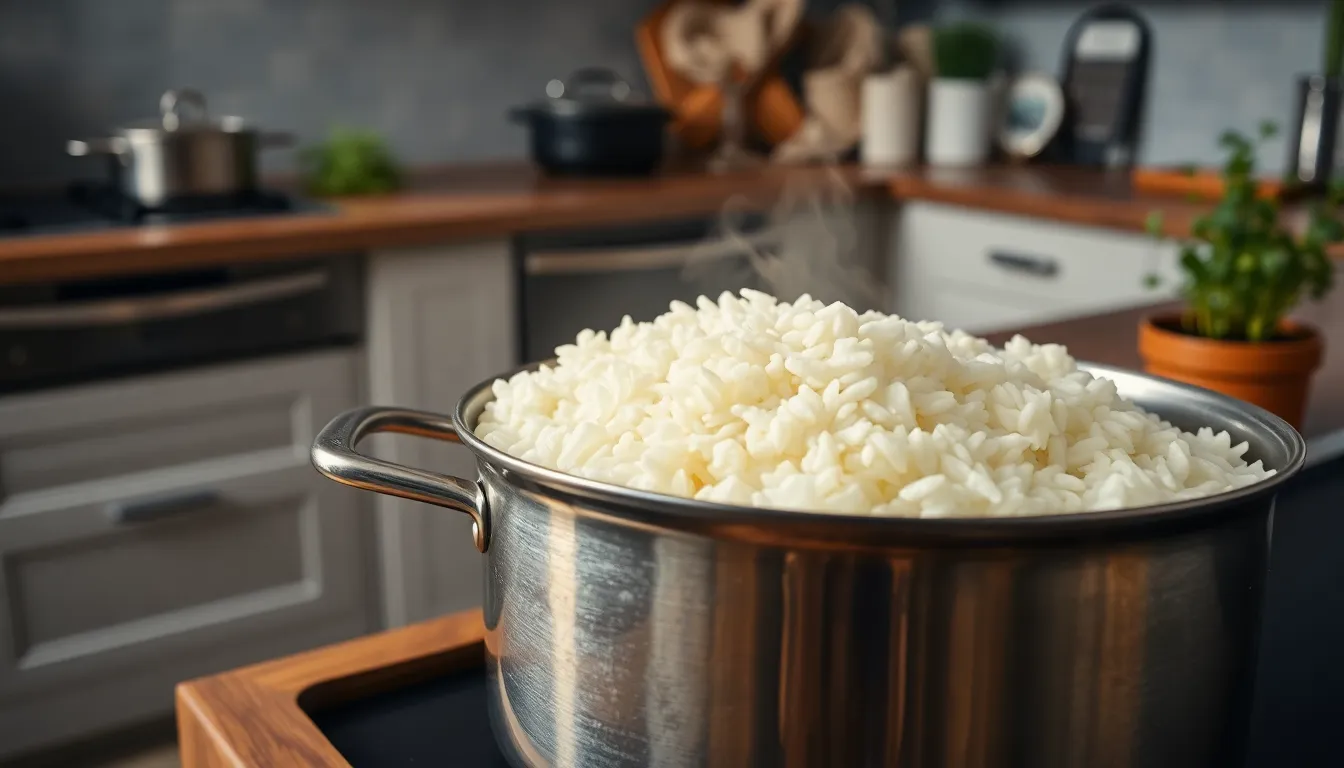Cooking rice might seem as simple as boiling water, but anyone who’s ever ended up with a sticky mess or a burnt pot knows it’s an art form. Whether it’s fluffy basmati or creamy risotto, the right techniques can transform a humble grain into a culinary masterpiece. Who wouldn’t want to impress dinner guests with perfectly cooked rice that’s light and airy, not a clumpy disaster?
Table of Contents
ToggleEssential Rice Cooking Tips
Measure rice accurately. A common ratio is two cups of water for each cup of rice. Rinse rice under cold water to remove excess starch, which helps prevent stickiness. Letting rice soak for 30 minutes can enhance texture and flavor.
Use a pot with a tight-fitting lid. This traps steam and moisture, ensuring even cooking. Bring water to a rapid boil, then reduce the heat to low once rice is added. Cover the pot and avoid lifting the lid during cooking, as this releases steam and alters the cooking time.
Add a pinch of salt for flavor. Salt enhances the rice’s natural taste without overpowering it. Incorporating a tablespoon of oil or butter can also improve flavor and prevent sticking.
Cook brown rice differently. It requires more water and a longer cooking time, typically 2.5 cups of water per cup of brown rice and about 40 to 50 minutes of cooking time. For added aroma, consider adding a bay leaf or herbs during cooking.
Fluff rice before serving. Using a fork, gently stir the rice to separate the grains. This step enhances texture and presentation. Serve immediately for the best taste, as rice dries out when left too long.
Store leftover rice properly. Cool it quickly and refrigerate within two hours to ensure food safety. Reheat thoroughly before serving again to prevent any cold spots. Following these tips guarantees perfectly cooked rice every time.
Choosing the Right Rice

Selecting the correct rice enhances the cooking process and influences the final dish’s texture and flavor. Understanding types and quality can make a significant difference.
Types of Rice
Long grain rice remains fluffy and non-sticky after cooking. Basmati rice offers aromatic qualities, making it perfect for pilafs and curries. Medium grain rice tends to be more tender and slightly sticky, yielding a creamy risotto. Short grain rice absorbs water well, ideal for sushi and sticky dishes. Brown rice, a whole grain option, delivers a nutty flavor but requires more water and longer cooking times. Jasmine rice provides a fragrant touch and complements Asian dishes well. Each type serves a different culinary purpose, so choosing based on the desired outcome is critical.
Quality Considerations
Selecting high-quality rice impacts not just taste but also overall cooking experience. Look for grains that are uniform in size, as this often indicates better quality. Choosing organic rice can reduce exposure to pesticides. Brands with minimal processing provide superior flavor and texture. Check for a clear packaging date to ensure freshness, and avoid bags with broken or discolored grains. Quality rice generally leads to better cooking results and enhances nutritional value. Prioritize purchasing from reputable sources to guarantee the best ingredients for every meal.
Preparing Rice for Cooking
Preparing rice properly sets the stage for perfect results. Following essential steps ensures fluffy and flavorful rice.
Rinsing and Soaking
Rinsing rice removes excess starch, preventing stickiness. Cold water works best for this process. He or she should rinse until the water runs clear, typically after several rinses. Soaking rice enhances texture and flavor. A soak of 30 minutes allows grains to absorb water, leading to a better cooking outcome. This process also shortens cooking time, improving overall efficiency in the kitchen.
Measuring Rice and Water
Accurate measurement of rice and water ensures consistent results. A common ratio of two cups of water for each cup of rice generally works well. For brown rice, 2.5 cups of water per cup is recommended, accounting for its longer cooking time. Using a measuring cup helps maintain precision. Following these ratios closely aids in achieving the desired texture. It’s essential to adapt measurements based on the rice type, as different varieties may require slight adjustments to the water ratio.
Cooking Techniques
Mastering rice cooking requires understanding different techniques that can enhance the final outcome. Each method brings unique advantages, ensuring the rice turns out perfectly every time.
Stovetop Method
This classic method involves boiling water in a pot before adding rinsed rice. Optimal texture results from using a tight-fitting lid, which traps steam and moisture. Once the water reaches a boil, reduce the heat to low and let the rice simmer. Timing varies based on the rice type; for white rice, 18 to 20 minutes suffices, while brown rice may require 40 to 50 minutes. Before serving, fluff the rice with a fork to separate grains and improve presentation.
Rice Cooker Method
Rice cookers simplify the process by automating cooking times and temperatures. After measuring rice and water, typically in a two-to-one ratio, place the mixture in the cooker. Ensure the lid closes completely to maintain heat and moisture. Many rice cookers have an automatic setting, switching to warm when the rice is cooked. Letting it rest for a few minutes before serving allows flavors to settle, resulting in fluffy rice.
Instant Pot Method
Using an Instant Pot offers speed and convenience, making it ideal for busy schedules. Start by adding rinsed rice and water in a 1:1 ratio, or 1.25:1 for brown rice, to the pot. Close the lid and seal the valve, then select the pressure cook function. Cooking times vary; white rice typically needs 4 to 6 minutes while brown rice requires about 22 to 28 minutes. Quick releasing pressure once it’s done helps prevent overcooking. Fluff before serving for the best texture.
Flavoring and Enhancements
Enhancing rice with flavors transforms a basic dish into a culinary delight. Exploring different flavorings enables cooks to personalize their rice creations.
Adding Broth or Spices
Substituting water with broth infuses rice with rich flavors. Vegetable, chicken, or beef broth can elevate taste significantly. Adding spices such as cumin, turmeric, or garlic powder introduces aromatic depth. Experimenting with herbs like bay leaves or parsley during cooking adds complexity. A sprinkle of salt before cooking improves the overall flavor profile. Tasting before serving ensures the perfect balance of seasonings.
Mixing with Vegetables or Proteins
Incorporating vegetables adds essential nutrients and vibrant colors. Peas, carrots, or bell peppers blend well with rice, enhancing both flavor and texture. Proteins such as chicken, shrimp, or tofu boost the dish’s heartiness and satiety. Cooking vegetables separately and folding them into the rice at the end maximizes flavor retention. Consider adding cooked proteins toward the end to maintain their juiciness. Garnishing with fresh herbs can brighten the experience and appeal visually.
Storage and Reheating Tips
Storing rice properly preserves flavor and texture. It’s essential to cool leftover rice within two hours after cooking. Placing it in shallow containers enhances cooling efficiency. Refrigeration lasts up to four days for cooked rice while freezing extends storage to three months.
Reheating rice requires attention to moisture. Adding a splash of water during reheating prevents dryness. Covering the rice with a damp paper towel retains steam and moisture. Microwaving on medium heat often works best, requiring one to two minutes.
Freezing rice can save time for future meals. Portioning rice into meal-sized bags or containers simplifies reheating. Labeling packages with dates ensures the oldest rice is used first.
Utilizing cooked rice in various dishes enhances versatility. Fried rice, soups, and casseroles transform leftovers into new meals. Incorporating fresh vegetables or proteins rejuvenates flavors and textures.
Checking for spoilage remains vital. Any off-smells or discoloration indicate that rice should be discarded. Following these storage and reheating tips ensures safe consumption and delicious results.
Perfectly cooked rice can transform any meal into a culinary masterpiece. By mastering essential techniques like accurate measurements and proper rinsing, anyone can achieve fluffy rice every time. The choice of rice type plays a crucial role in flavor and texture, so selecting high-quality grains is vital.
Incorporating flavor enhancements and experimenting with cooking methods can elevate rice dishes to new heights. Proper storage and reheating practices ensure that leftover rice remains delicious and safe to eat. With these tips in hand, it’s easy to impress family and friends, making rice a standout feature at any dining table.




